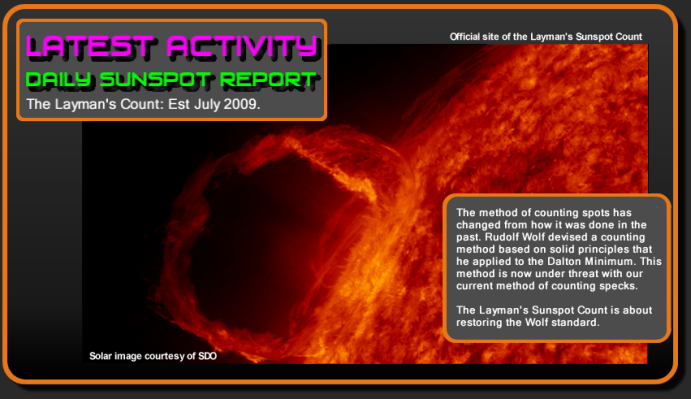
The Laymans Sunspot Count updated to May 2022. SC5/24 and SC6/25 have been aligned at their starting points, hence the gap at cycle minimum.
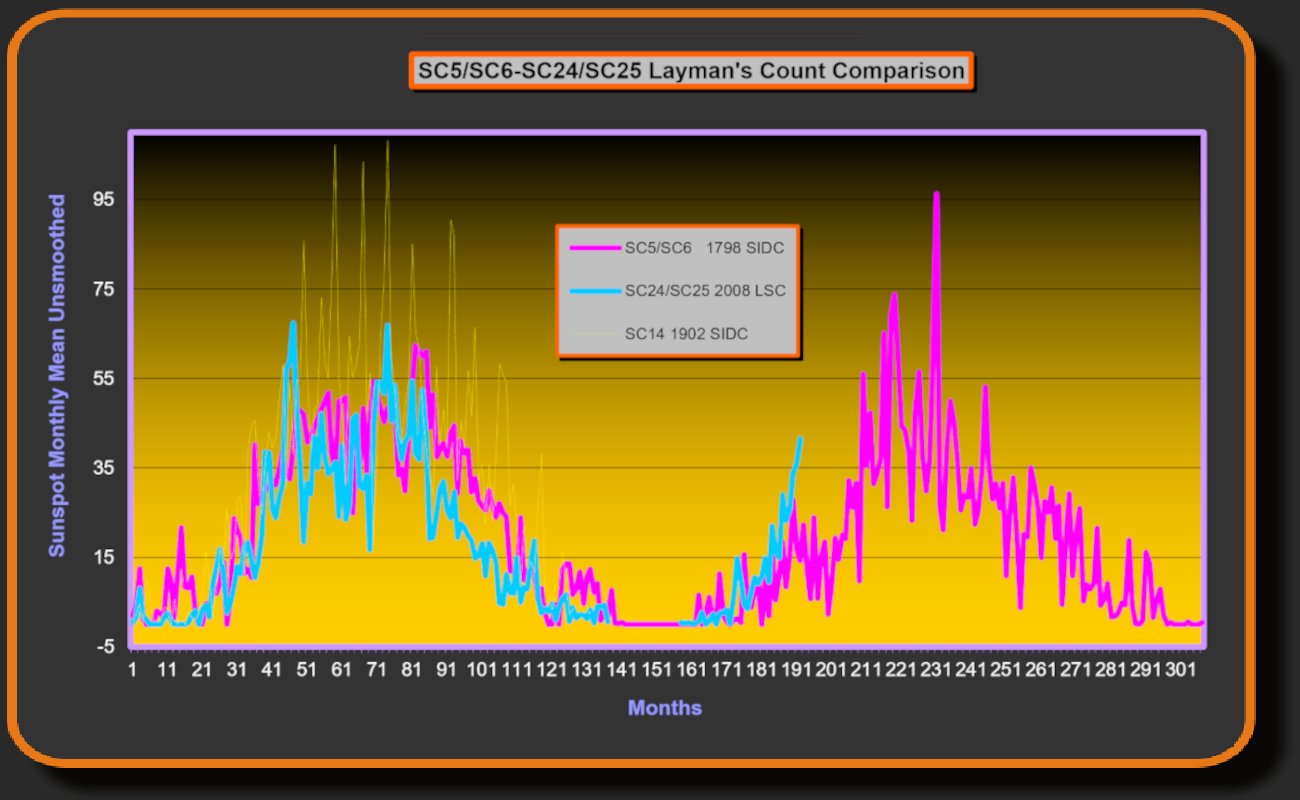
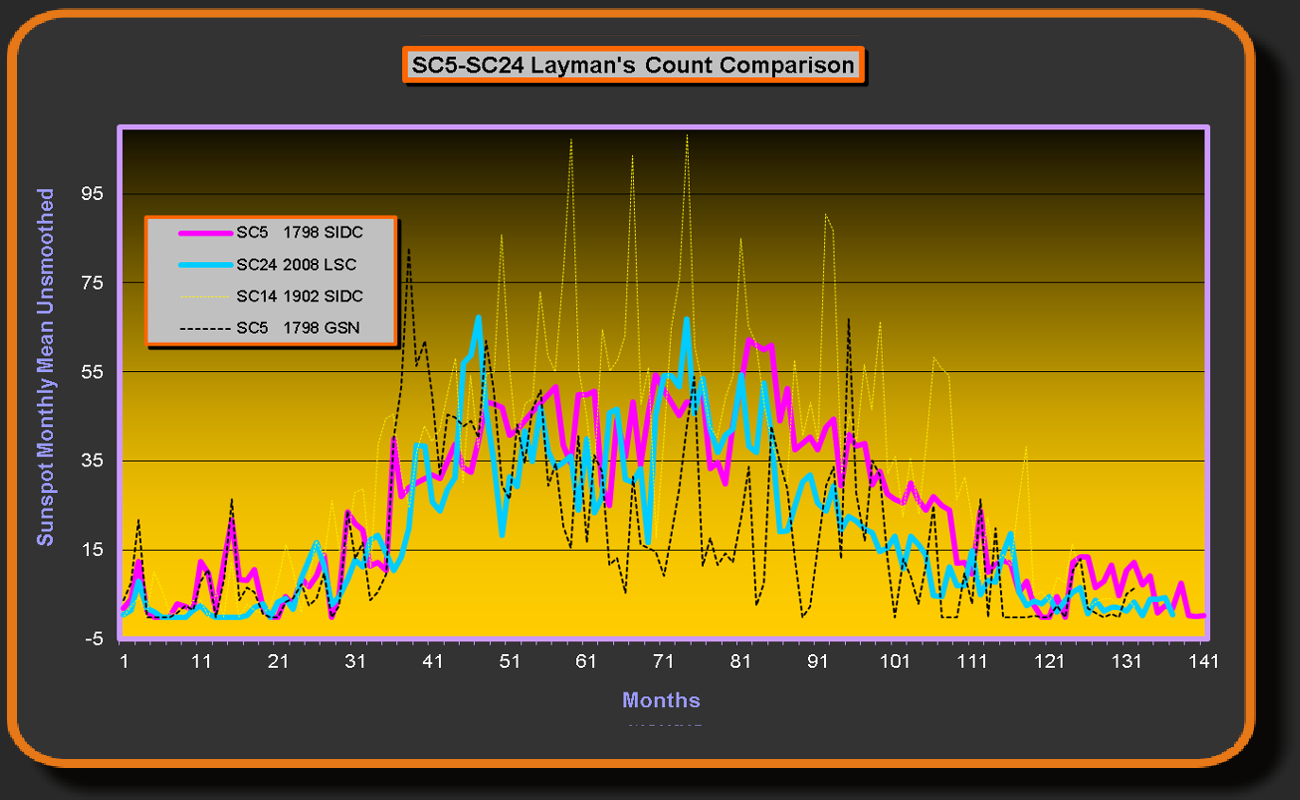
NOTE: (SILSO) values are pre July 15th 2015 (V1). Post June 2017 values are V2 x .43
The Layman's Sunspot Count has moved from a daily count to a Quarterly update because of a Computer failure with daily updates being unworkable. The good news is we have almost a whole solar cycle of data that can be compared to the SILSO V2 Sunspot Count. By applying a factor of .43 (instead of .6) we get a very good match.
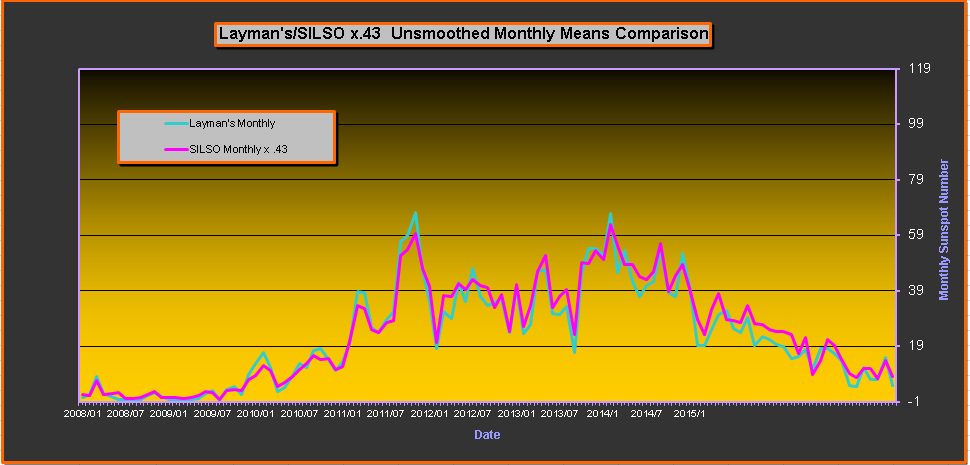
The .43 reduction factor is right in the ballpark when considering the SILSO value of .6 corresponds with about a 12% allowance for the Waldmeier error introduced around 1945. The Waldmeier correction factor needs to be around 20-22% along with other factors affecting the modern count. The new method of scaling the existing SISLO V2 sunspot record will allow the LSC to continue and to be utilised for comparison of SC24/25 to SC5/6.
The monthly LSC and F10.7 flux comparison graphs will be updated on a quarterly basis, updates will be alerted via twitter and facebook.
SOLAR CYCLE 20/24 F10.7 FLUX COMPARISON.
To compare solar cycles we can also use the F10.7 radio flux values that have been recorded since 1947 in Canada. Solar cycle 20 was a weak cycle which is currently looking strong against solar cycle 24. Data is taken from the AU adjusted monthly average values.
SC20 & SC24 have a lot in common, they both experience angular momentum disturbance measured at the Sun. SC24 has a much higher degree of disturbance that will guarantee a lower cycle than SC20 if the theory is correct.
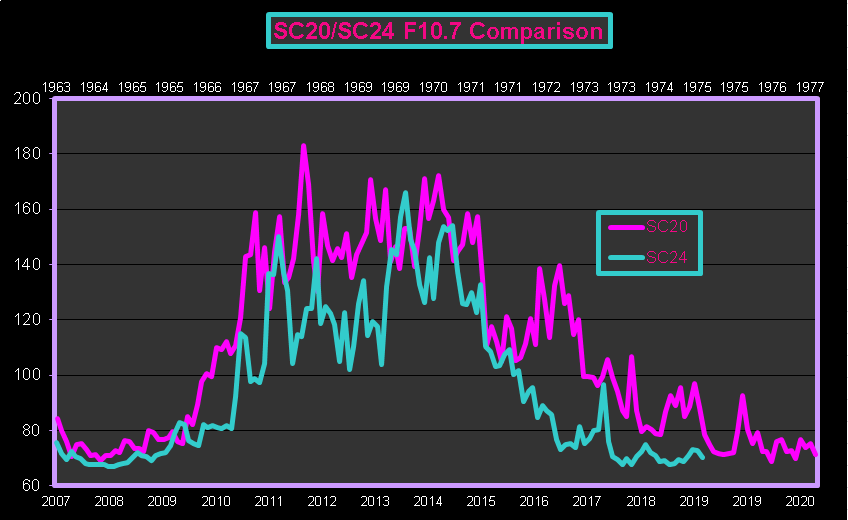
Updated Quarterly.
| Cycle 24 record sunspot area: Region 2192 @ 75727 pixels on 23/10/2014. |
A BRIEF HISTORY ON THE EVOLUTION OF THE SUNSPOT COUNT.
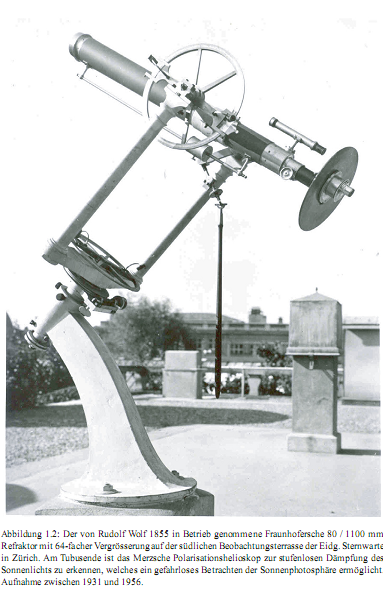 |
|
| Rudolf Wolf in 1855 commissioned the Fraunhofer 80mm / 1100 mm Refractor 64x telescope, here observed on the southern terrace of the Swiss Federal Observatory in Zurich. A Merzsche Polarization filter system for variable adjustment of detectable sunlight fitted, which enables safe viewing of the solar photosphere.Click on the pic for a larger view |
|
Johann Rudolf Wolf born in 1816 reconstructed the sunspot record back to 1749 using the geomagnetic record as his baseline. Wolf used this background scale to adjust the values taken before 1847 to align with his count, later in 1902 Wolfer looks to have reduced Wolf's SC5/6 values after discovering extra data not available to Wolf (under investigation). Wolf's reconstruction is also backed up by the Group Sunspot Number which shows very similar cycles during the Dalton Minimum. The GSN employs 32 observers during this period (only several were available to Wolf). The depth of the Dalton Minimum is beyond question.
Wolf was the inventor of the sunspot formula R=k(10g+s) which translates to sunspot number = a local adjustment factor to allow for telescope differences X 10 for each group + 1 for each spot. During his lifetime while counting spots he used the K factor to align other observers and indeed his own records that were taken with his smaller portable telescope. The portable telescope has a 40mm aperture and a magnification of 40x 20x compared to the larger telescope of 64x, the larger telescope having an aperture of 80mm and a focal length of 1100mm. To my knowledge both telescopes used a polarizing filter and did not use the projection method. During his time Wolf did not count small spots and specks, he set a threshold size that is now lost to science but it was set for two very good reasons.
1. He was trying to match his records with the past, the prior records were recorded through telescopes of lesser technology. Even so he had to make adjustments to the older record.
2. His own telescope only saw the minor spots/specks when conditions were good. (Today we can see even smaller specks with the 150mm equipment)
Wolf set a threshold for good reason, we should have preserved his vision.
His successor Wolfer in the 1880's marks a change in direction in how sunspots are counted. Wolfer began counting all small spots and pores along with recording each umbral area within a penumbra which differs from the Wolf method. He introduced a reduction factor to his count to align with Wolf. Exactly how he arrived at his factor is currently being investigated but Wolfer crosschecked the 0.6 K factor for 17 years against Wolf's count and telescope. Update Sept 2012: new data suggests the original Wolf 80mm was greatly enhanced in 1864, with Wolf apparently not using the instrument after that. Later in 1883 Wolfer produced daily drawings on 25cm projection, which is thought to greatly enhance the spot counting performance. When Wolfer applied his 0.6 K factor he did not experience a grand minimum, Wolfer must have been unaware that during grand minima where the speck count could be much higher the 0.6 K factor would not be sufficient to stop the values being overstated. The ratio of specks is where the potential for divergence lies, recent data is showing that SC24 is experiencing a large drop off of large spots with an increase in small spots.
Brunner followed on from Wolfer and continued his method up to 1945, where Waldmeier took over and a step change was introduced. Recent analysis HERE suggests the modern SILSO sunspot record is at least 22% higher than the late 1880's Wolfer values. Waldmeier introduced a new method of counting spots where extra weighting was applied to groups, the weighting factor is as follows: “a speck is counted once, A larger one but still without penumbra {a pore} is given the statistical weight 2 [i.e. counted twice], a small ordinary spot 3, and a large one 5 [i.e. counted 5 times]“ (Locarno have also scored single spots with 4&6). This addition to the historical count marks the greatest movement away from the Wolf method that needs adjustment when comparing the modern count. Waldmeier may have confused Wolfer's change to the umbral counting as a weighting system already introduced, this is still an area of current investigation. Update Sept 2012: There is emerging evidence that Brunner was using a weighting system, how this affected his count is still unclear.
The SIDC when taking over from Waldmeier in 1981 calibrated their results against the Waldmeier count and still use the weighting factor at the SIDC reference station at Locarno, which has been in operation for over 50 years. When comparing the NOAA adjusted count to the SIDC count there are some inconsistencies prior to 2001 that are currently being investigated. Leif Svalgaard and myself have opposing views on this issue, which the SILSO have taken onboard.
The evolution of the sunspot record has made it difficult to formulate a homogeneous record (the SILSO are doing a great job in a difficult arena). Before Wolfer there was mainly one primary observer who was at the mercy of local conditions. Today we have multiple observers that must put upward pressure on the historic counts, the SILSO have 80 observers covering the globe of which 30% are professional. These results are averaged over 24 hours to gain a result. Modern observatories mainly use the same magnification as Wolf's larger telescope but that is the only equal comparison. The aperture lenses are nearly twice the diameter and the focal lengths are more than twice the length of Wolf's 64x scope, the design of the optics is also unknown on the modern scopes which can also make quite a difference, these motor driven, auto cooled/no tube telescopes are a far cry from Wolf's telescopes (Note: according to Leif Svalgaard the Locarno telescope is stopped down to 80mm). Wolf used a 1.5 K factor when using his smaller telescope, but 1.5 x zero is still zero which suggests Wolf must of been able to see his sunspot threshold through the smaller telescope.
We must also be aware of modern counting methods that are different to Wolf's method, NOAA have decided to run their own system that is not designed to line up with the past. In essence they do not take on Wolfer's 0.6 reduction factor to account for the small spots and pores that Wolf did not count. NOAA have their method which differs from the historical record that is unfortunately prevalent across many media outlets.
The SILSO count is the internationally accepted standard that follows the Wolfer method. The Waldmeier step is currently built into this standard.
Isolating specks by setting a "Wolf like threshold" and adopting the SILSO count for the groups that make the grade the Layman’s Count although not perfect, attempts to redress some of the modern issues and should compare more favorably to Wolf’s (and possibly Wolfer's) reconstruction of the Dalton Minimum cycles.

SOME BASIC MATHS TO DETERMINE SPECK DETECTION.
When it comes to observing specks there are two main players. The size of the aperture lens and the atmospheric conditions. Below is a list of what is possible in arc seconds from the appropriate lens diameter of a refractor type telescope.. This assumes perfect viewing and distortion free lenses. 1 arc second is equal to 725 kilometers on the solar surface.
| Diameter |
Arc sec |
Km |
| 40mm |
2.93 |
2124 |
| 50mm |
2.32 |
1682 |
| 70mm |
1.66 |
1203 |
| 80mm |
1.45 |
1051 |
| 110mm |
1.05 |
735 |
| 150mm |
.77 |
558 |
Using the current SDO images it can be determined that the Sun is about 3800 pixels wide in the 4096 x 4096 images. The Sun is 1392000 kilometers across so each pixel measures 366 kilometers. The smallest specks recorded by Catania look to be about 700 kilometers across. If so the Wolf 80mm telescope on a perfect day with perfect optics is not capable of achieving this resolution, the 40mm aperture is nowhere near it. The current Wolfcam is also not capable of picking up the smallest specks that are counted today.
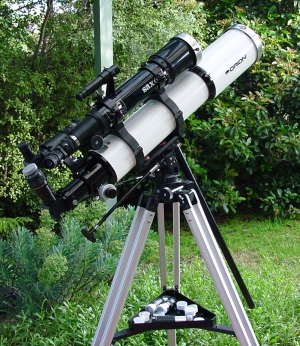 Atmosphere conditions or "seeing" is the next vital component. The very best conditions are achieved at night high up on mountain ridges that face the larger oceans. The very best conditions yield a max of 0.5 arc seconds. During the day conditions are weakened by solar activity in the atmosphere, so the atmosphere plays a big part in what is observable. Catania is capable of seeing 1000km wide specks in level 3 conditions. It becomes obvious that the new 150mm telescopes are capable of recording much smaller specks than Wolf's 80mm telescope.
Atmosphere conditions or "seeing" is the next vital component. The very best conditions are achieved at night high up on mountain ridges that face the larger oceans. The very best conditions yield a max of 0.5 arc seconds. During the day conditions are weakened by solar activity in the atmosphere, so the atmosphere plays a big part in what is observable. Catania is capable of seeing 1000km wide specks in level 3 conditions. It becomes obvious that the new 150mm telescopes are capable of recording much smaller specks than Wolf's 80mm telescope.
Pictured left is the Layman's dual telescope, the top telescope is a 70mm aperture stopped down to 40mm set up with an old style Kellner 40x lens 20x lens which is a very close replica to Wolf's handheld telescope. The larger telescope using modern optics is an Orion 110mm aperture premium ED stopped down to 80mm with a 64x lens and should be very close to the original Wolf observatory telescope along with the official Locarno telescope used by the SILSO as its benchmark. Both telescopes are fitted with "Seymour" solar filters. Click on the pic for a larger view.
In summary we have several contributing factors that are undeniably adding to the modern sunspot record.
1. The Waldmeier factor adding 22% via a different counting method that is still used by SILSO today (Leif Svalgaard) UPDATE: In July 2015 the SILSO SSN records have been revised and now discount the post 1945 SSN values by about 12% (SC24). The revision has not allowed sufficiently for the Waldmeier factor and still has a way to go.
2. A higher speck ratio during SC24 that was not considered by Wolfer when applying his 0.6K factor. Wolfer compared his count with Wolf's baby 20x telescope which is less than satisfactory. Wolf's eye sight was also questionable during this period.
3. The projection method introduced in 1883 producing a step increase in spot numbers that is shown via many metrics.
4. Moving to multiple world wide viewers taken over 24 hours increasing available coverage.
5. Modern 150mm telescopes able to resolve smaller specks than Wolf's 80mm & 40mm telescopes (this would mainly apply on days where Catania is used instead of Locarno) but the original Wolf 80mm telescope was upgraded significantly when Wolfer and his successors took over.
There is one outstanding issue: Does the modern projection method apply a 64X magnification at the viewing aperture or at the projected image? (New evidence according to private communications suggest that the Locarno counting method is performed by eye through the lens (stopped to 80mm), while the actual drawing is recorded at the lens width of 150mm)
Thanks to those supporting the LSC on WUWT, Svalgaard continues to call the method "uncalibrated junk" but misses the point as usual. The LSC removes the Waldmeier factor (like a bad calibrator) in the current record which is a universal requirement and it also adjusts for the increased speck ratio experienced during grand minima. Wolf used a tiny 40mm 20x telescope for the larger part of his observations which had a conversion factor to take it up to the 80mm telescope that Wolfer used. Wolfer introduced a further 0.6 correction factor because he counted all specks (Wolf had a threshold), but both correction factors where tested and applied outside of grand minimum type cycles...they had no way of knowing or how to correct for a grand minimum type cycle. The LSC in effect removes the "bad" calibration errors of the past.
Which ever way you cut it SC24 is following Wolf & Wolfers combined reconstruction of SC5 and looks nothing like SC14 (Svalgaard continues to make wild claims?). SC24 will be the lowest cycle in 200 years.
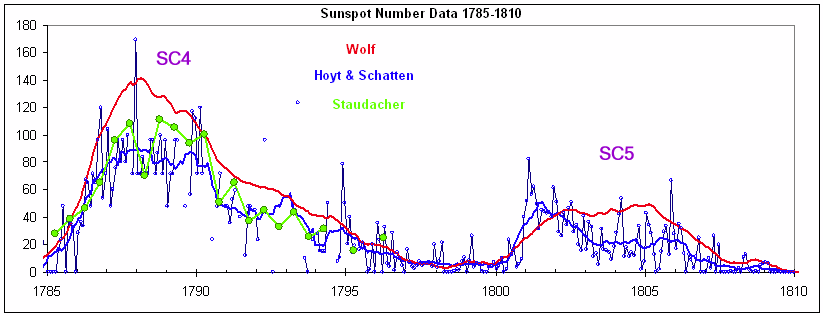
Image courtesy of Leif Svalgaard.
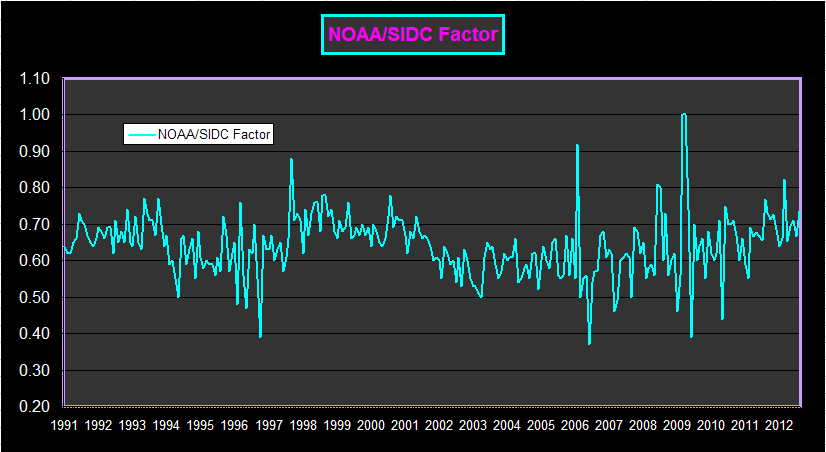
Graph showing that the difference between NOAA and the SIDC(SILSO) has been mostly constant but has drifted higher in the last few years suggesting either the SIDC is counting more or NOAA is counting less of late.
-------------------------------------------------------------------------------------------------------------------------------------------------------
THE LAYMAN'S COUNT METHOD & HISTORY
There has been a lot of comments recently about the tiny specks that have been counted as sunspots. A tiny speck can get a daily count of 11 which severely skews the record. NOAA is another magnitude higher than the SILSO, NOAA using a different method not meant to compare with the historical count. During times of high speck count we need a new standard to record sunspots that gives us a realistic measure of today's activity verses the last Grand Minimum.
The SOHO 1024 x 1024 Continuum images originally provided a good platform to measure the pixels involved in a Sunspot. Initially it had to be determined what a standard sunspot should represent in size and density, to try and represent a minimum counter like Wolf may have done 200 years ago. After some deliberation with fellow enthusiast Robert Bateman, a minimum standard was established.
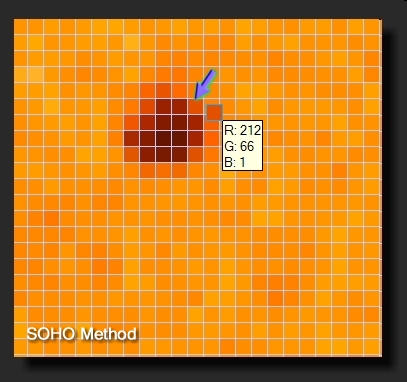 To be counted, a sunspot or group must have 23 pixels which have a reading in the green channel of 0-70 for at least 24 hours. Note: This has now been superceded, see below.
To be counted, a sunspot or group must have 23 pixels which have a reading in the green channel of 0-70 for at least 24 hours. Note: This has now been superceded, see below.
All pixels in a digital image have a RGB reading which split out into separate Red, Blue, Green channels and can be easily measured and counted in one action using a freeware graphics program called GIMP.
So the standard was set, which now enabled us to go back over the records and weed out the offending specks and blank days.
The official Layman's Sunspot Count is compared against the SILSO record which is considered conservative when compared with other institutions involved. Basically we use the same sunspot number as SILSO but replace them with zero on days that don't make the grade. When the SILSO count is made up of two or more areas and if any of the area's do not make the Layman's Count, the overall SILSO daily count will be reduced by the areas that fail. Spots that count 23 pixels and over before midnight and then continue on to pass the 24 hour rule will take the SILSO value of that day. Existing Spots that have made the grade but measure less than 23 pixels at midnight are not counted on the next day.
Displayed below is the recent solar activity along with the results of the weeded SILSO record. The data & graphs will be updated monthly soon after SIDC post their record which is usually at the start of each month.
NEW LAYMAN'S COUNT METHOD UTILIZING THE SDO HIGH DEFINITION IMAGES.
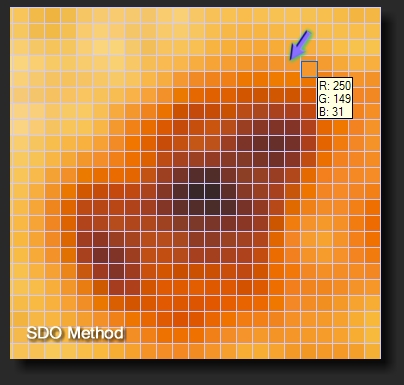 The SDO images are now available and used for the Layman's Sunspot Count. Several high quality images are provided every hour making the counting process more accurate and reliable. The method will use the 5Mb 4096 x 4096 SDO fast-look Continuum images which will be measured at 08:00 UTC daily.
The SDO images are now available and used for the Layman's Sunspot Count. Several high quality images are provided every hour making the counting process more accurate and reliable. The method will use the 5Mb 4096 x 4096 SDO fast-look Continuum images which will be measured at 08:00 UTC daily.
The minimum pixel area is now 333 pixels (0-150 in the green channel) which calibrates to the old 23 pixel threshold used in the SOHO images. The area conversion factor is 6.91%. The 24 hour rule will stay in place. Update 21st Dec 2012: New threshold limit of 336 arising from Mac platform change. All values rising 1% on gimp2 Mac version.
Sunspot areas included in the daily report indicate regions that pass the 336 pixel threshold but are still subject to the 24 hour rule. Because the SILSO can split NOAA numbered groups, final determination cannot be performed until month end. As per Wolf's original method a spot is only counted when it has a visible Umbra.
LAYMAN'S SUNSPOT THRESHOLD 333 PIXEL EXAMPLE.
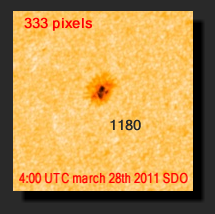
On March 28th 2011 at 4:00 UTC NOAA sunspot region 1180 (11180) was recorded by the SDO satellite. This region matches exactly the Layman's threshold and can be used to compare a likely threshold used by Wolf. When looking at region 1180 through the Layman's 40mm Wolf replica handheld telescope the penumbra/umbra areas are NOT distinguishable. (Update Sept 2012, it is now apparent the Wolf handheld had a magnification of 20x not 40x as previously suggested) A group is not counted unless one spot within that group meets or exceeds 333 pixels. Now 336 pixels, see above.
| IMPROVEMENTS TO THE LAYMAN'S SUNSPOT COUNT: June 2012 |
|
| In the past because of internet restrictions I was unable to perform the daily update around the same time as the SILSO pilot station (Locarno). Now that the restriction is solved I will use the 08:00 UTC image which is about the average time of the Locarno image making the counting a little more precise, plus I will have access to the drawing. I have also had several requests to post a daily LSC value along with a running monthly average which with a minor change I can now provide. I think this will be a major improvement and should highlight the daily differences between the different counting methods. In the past I used the daily SILSO value to work out the daily K factor for the Locarno drawing which I had to wait until the end of month to obtain. I will now assume a daily 0.6 K factor which is the long term monthly average and should not make any noticeable change to the LSC monthly value. |
|
-------------------------------------------------------------------------------------------------------------------------------------------------------
Previous Years Spotless Records.
SIDC 2009 spotless days - 261
Layman's 2009 spotless days - 314
Layman's spotless days June 2008 - June 2009 - 349
SIDC 2010 spotless days - 44
Layman's 2010 spotless days - 98
---------------------------------------------------------------------------------------------------------------------------


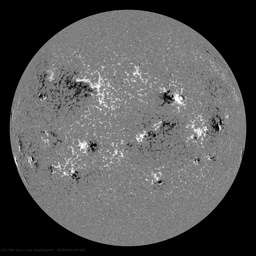
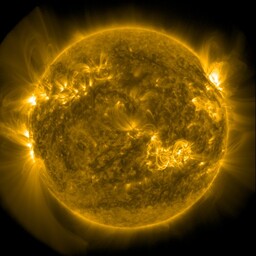

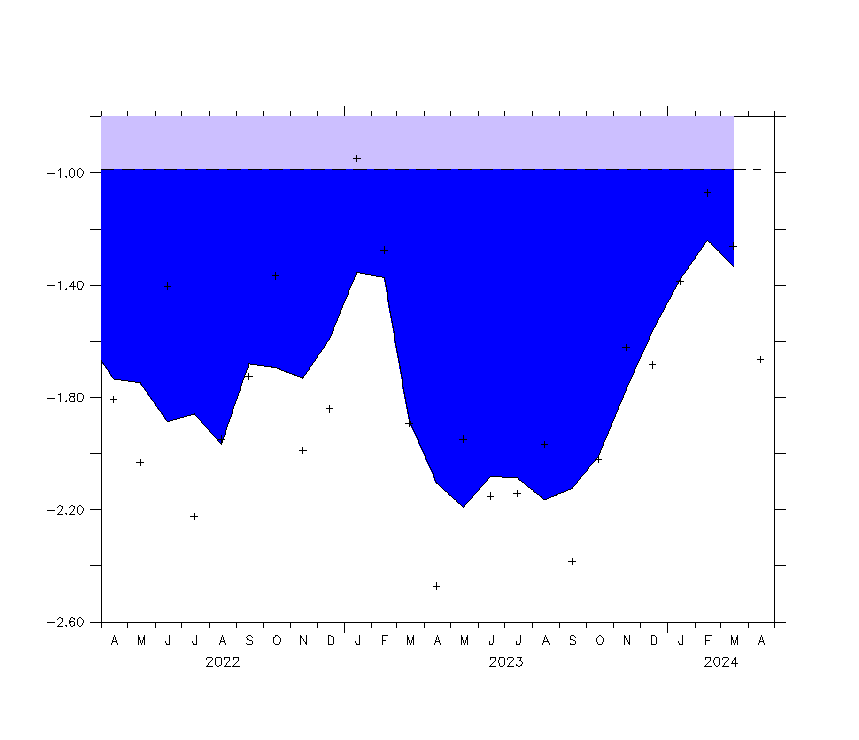
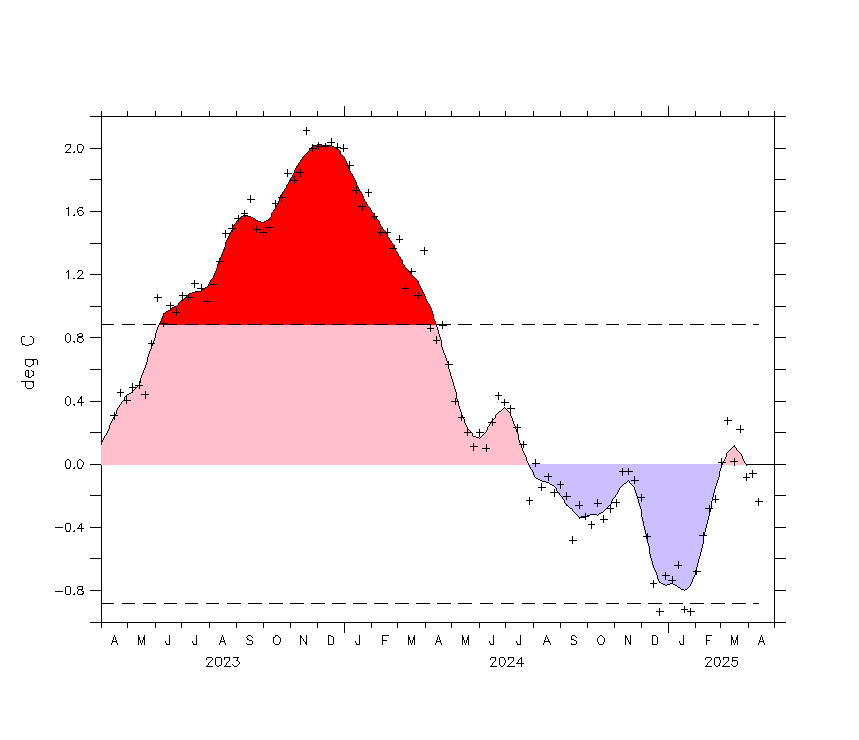
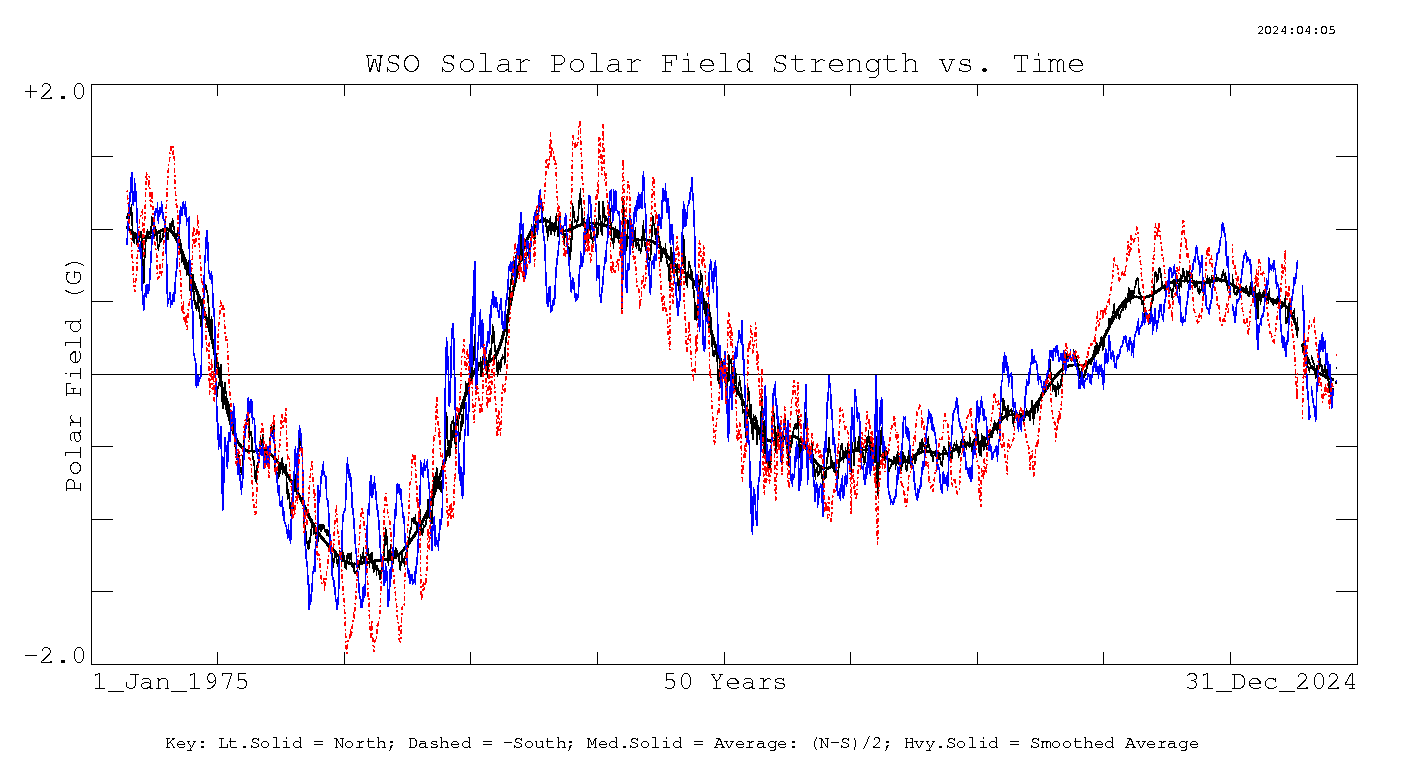











 The SDO images are now available and used for the Layman's Sunspot Count. Several high quality images are provided every hour making the counting process more accurate and reliable. The method will use the 5Mb 4096 x 4096 SDO fast-look Continuum images which will be measured at 08:00 UTC daily.
The SDO images are now available and used for the Layman's Sunspot Count. Several high quality images are provided every hour making the counting process more accurate and reliable. The method will use the 5Mb 4096 x 4096 SDO fast-look Continuum images which will be measured at 08:00 UTC daily.